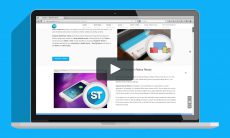Today, 89% of B-to-B marketers in the U.S. are using social media, says a study conducted by iTracks and the Business Marketing Association (BMA). In fact, B-to-B use of social media may have even eclipsed that of consumer marketers, according to another report from White Horse Productions. But the B-to-B marketers I talk to still sound confused. “What should I be doing,” they ask. “What’s really worth my time?” What you want to do is get out of the hype, get real, and get results. Here’s a simple plan of attack.
First, get busy on LinkedIn. This is the no-brainer of B-to-B social media marketing. You, your company, and all your employees need to take maximum advantage of the exposure. Your LinkedIn to-do list looks like this:
- Fill out your profile 100%. LinkedIn will prompt you on how to make sure every element is captured. Encourage your employees to set up their profiles, including their skills lists. Prospective customers will check out you and your staff as part of their due diligence before doing business with you—so be prepared.
- Set up a company page, with your logo image, plus a crisp, benefit-laden company description. Invite links from your customers, suppliers and friends. Along with a Google search, this is how you will be found in the marketplace.
- Join groups, or set up fresh groups, in your field of expertise.
- Post regular status updates in the micro-blog area LinkedIn provides.
Then, examine your marketing objectives. Each social medium has its own strengths and weaknesses. What you want to do is get the most bang, by applying them to their best use. Here’s a typical array of business marketing objectives a company may be pursuing. Let’s look at how social media can be applied to support what you’re trying to do.
Understand your market opportunity. In other words, market research. What customers and prospect are talking about on social media gives companies valuable insight into customer needs, issues and trends. You can set up a listening post using tools like Radian6, or simply set up an RSS feed from sources like blogs, Twitter, LinkedIn, Focus, Quora, YouTube and Wikipedia, so you can keep current with what’s being said in your field.
Stand out in the crowd. Social media can help you differentiate your company from your competition. If you want to be seen as a thought leader in your industry, or a trusted advisor to businesses trying to solve problems, then it’s all about content. You’ll be publishing white papers, research reports and case studies, and tweeting about them. Or publish an informative blog and promote it via Twitter and LinkedIn micro posts. Blogging can be a powerful way to establish thought leadership, but it does represent a risk. Only start a blog if you have valuable content to present, and if you can commit to keeping it up.
Editorially, the tone should be informative, not sales-y. If you don’t have good writers in house, there are plenty of freelancers available to help. Another tip: If you hesitate to take on a blog on your own, you might provide guest posts to influential blogs managed by someone else. (As you see, this is the route I took for myself—it’s great!)
Find new customers. There’s a lot of hue and cry out there about whether social media can help you find prospective customers. Of course it can. The trick in B-to-B is to turn your social media messaging into a lead generator, with the addition of 3 essential elements:
- A compelling offer, such as an intriguing research report or white paper.
- A clear call to action, like “Download now.”
- A dedicated landing page that captures the respondent’s contact information.
We can debate the merits of gating your content for lead generation, versus making it available to all, for thought leadership. A worthy discussion. But if your objective is to launch a business relationship with a prospective buyer, than the lead generation route is the way to go. So add an offer and call to action to your blog posts and tweets.
Expand current customer value. Social media can serve as another useful “touch” in your ongoing effort to penetrate accounts and deepen your relationship with current customers. Encourage customers to follow you on Twitter, subscribe to your blog, or connect with you on LinkedIn. A smart salesperson will link to every possible contact at a current account, and post company and product news in the LinkedIn microblog a couple times a week.
Now, what about Facebook? With 845 million users worldwide, it can’t be ignored. Ask yourself whether your customers are there, and whether they want to interact with you there.
According to Globalspec,66% of industrial workers have Facebook accounts, but 67% of them say they cannot access Facebook from their office computers. Given its vast reach, at the very least set up a company page on Facebook—for employee recruitment, if nothing else. And don’t forget YouTube, the world’s second largest search engine. Set up a channel to give exposure to your product demos, training videos and corporate videos.
So, with that, you have a reasonable attack plan for cutting through the hype and putting social media to work for you in a manageable way. Now, what have I forgotten? Do you have any good social media applications you can share with the rest of us business marketers?





